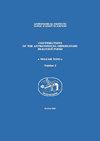太阳氢Lyα辐射变化对电离层d区电子密度的影响
IF 0.4
4区 物理与天体物理
Q4 ASTRONOMY & ASTROPHYSICS
Contributions of the Astronomical Observatory Skalnate Pleso
Pub Date : 2022-12-01
DOI:10.31577/caosp.2022.52.3.132
引用次数: 0
摘要
. 太阳发出的氢Ly α辐射是光电离过程的主要来源,因此也是电离层d区自由电子产生的主要来源。入射Ly α辐射强度的变化影响电子密度的变化,它们表现为周期性的日变化和季节变化,以及太阳周期的变化。安静电离层d区(琼dr)模型描述了这些周期性变化。在这项研究中,我们分析了一年中的变化和平滑日太阳黑子数的变化(这两个过程都会影响d区入射辐射的强度)如何影响与安静条件相关的电子密度变化。所提出的建模是基于QIonDR模型在欧洲部分地区的结果,该结果由极低频(VLF)信号发射机ICV(意大利撒丁岛)和DHO(德国下萨克森州)以及AWESOME(用于观测建模和教育的大气天气电磁系统)接收器位置(塞尔维亚贝尔格莱德)所定义,并将QIonDR模型应用于实际信号。本文章由计算机程序翻译,如有差异,请以英文原文为准。
Influence of variations in the solar hydrogen Lyα radiation on the ionospheric D-region electron density during a year and solar cycle
. The hydrogen Ly α radiation emitted from the Sun is the main source of photo-ionization processes and, consequently, of the free electron production in the ionospheric D-region. Variations in the intensity of the incoming Ly α radiation affect changes in the electron density and they show up as periodic daily and seasonal changes, and changes during a solar cycle. The Quiet Ionospheric D-Region (QIonDR) model describes these periodic changes. In this study, we analyse how changes during a year and changes in the smoothed daily sunspot number (both processes affect the intensity of incoming radiation in the D-region) affect the electron density changes related to quiet conditions. The presented modelling is based on the results of the QIonDR model obtained for the part of Europe defined by the positions of the very low frequency (VLF) signal transmitters ICV (Sardinia, Italy) and DHO (Lower Saxony, Germany), and the AWESOME (Atmospheric Weather Electromagnetic System for Ob-servation Modeling and Education) receiver position (Belgrade, Serbia) in application of the QIonDR model on real signals.
求助全文
通过发布文献求助,成功后即可免费获取论文全文。
去求助
来源期刊
CiteScore
1.10
自引率
20.00%
发文量
4
审稿时长
>12 weeks
期刊介绍:
Contributions of the Astronomical Observatory Skalnate Pleso" (CAOSP) is published by the Astronomical Institute of the Slovak Academy of Sciences (SAS). The journal publishes new results of astronomical and astrophysical research, preferentially covering the fields of Interplanetary Matter, Stellar Astrophysics and Solar Physics. We publish regular papers, expert comments and review contributions.

 求助内容:
求助内容: 应助结果提醒方式:
应助结果提醒方式:


